Physics is a study of matter and its motion, along with related concepts such as energy and force. The Vedas and Puranas have given the path to Vedic Physics it’s called “Vedic Physics“ or “Bouthika Shastram’. In Classical Physics is generally concerned with matter and energy on the normal scale of observation, while much of modern physics is concerned with the behavior of matter and energy under extreme conditions or on a very large or very small scale. For example, atomic and nuclear physics studies matter on the smallest scale at which chemical elements can be identified.
Vedic Sages Went To Deep Meditation, Concentration, Contemplation and Discovered A Large Number of Permanent Laws about Vedic Physical Sciences. Vedas, Upanishads, Puranas, Shad-Darshanas (among them Sankhya, Vaishesika, Nyaya Darshanas) had postulated many theories about Universe and its Atomic Structure in their own perspective.
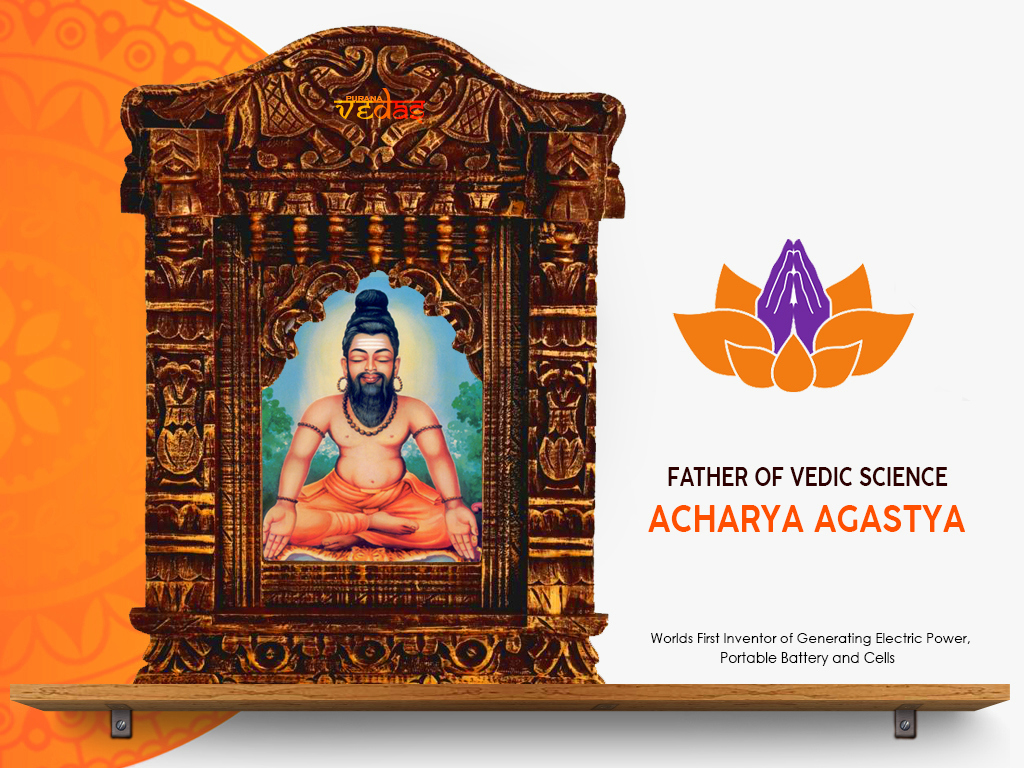 Acharya Agastya was an honored Vedic sage of Ancient India. In the Vedic tradition, he is a noted recluse and an influential scholar in diverse languages of the Indian subcontinent. He and his wife Lopamudra are the celebrated authors of some hymns in the Sanskrit text Rigveda and other Vedic literature.
Acharya Agastya was an honored Vedic sage of Ancient India. In the Vedic tradition, he is a noted recluse and an influential scholar in diverse languages of the Indian subcontinent. He and his wife Lopamudra are the celebrated authors of some hymns in the Sanskrit text Rigveda and other Vedic literature.
Maharshi Agastya is traditionally attributed to be the author of many Sanskrit texts such as the Agastya Gita found in Varaha Purana, Agastya Samhita found embedded in Skanda Purana and the Dvaidha-Nirnaya Tantra text. He is also referred to as Mana, Kalasaja, Kumbhaja, Kumbhayoni, and Maitravaruni after his mythical origins.
He is one of the Vedic sages found in ancient sculpture and reliefs in Vedic Places of South Asia, and Southeast Asia such as in the early medieval era Shaiva temples on Java Indonesia. He is the principal figure and Guru in the ancient Javanese language text Agastyaparva, whose 11th-century version survives.
Maharshi Agastya is considered the father of Science, traditional medicine among many other streams of knowledge. He described, and instructions for, The creation of medicines for many types of fevers, cancer, treatments for importance, abdominal problems, brain and eye problems, bone problems, etc. The great Maharshi also highlighted the importance of using chemical compounds in different combinations for the benefit of mankind. The Agastya Samhita, sometimes called the Sankara Samhita is a section embedded in Skanda Purana. It exists in many versions and is structured as a dialogue between Skanda and Agastya. The ancient text of Agastya Samhita describes the method of making an electric battery, and that water can be split into oxygen and hydrogen.
For Generating Electricity, Sage Agastya had used the following material:
 1.One Earthen pot
1.One Earthen pot
2.Copper Plate
3.Copper Sulphate
4.Wet Saw Dust
5.Zinc Amalgam
संस्थाप्य मृण्मये पात्रे ताम्रपत्रं सुसंस्कृतम्।
छादयेच्छिखिग्रीवेन चार्दाभि: काष्ठापांसुभि:॥
दस्तालोष्टो निधात्वय: पारदाच्छादितस्तत:।
संयोगाज्जायते तेजो मित्रावरुणसंज्ञितम्॥
This means, “Place a well-cleaned copper plate in an earthenware vessel. Cover it first with copper sulfate and then with moist sawdust. After that, put a mercury-amalgamated zinc sheet on top of the sawdust to avoid polarization. The contact will produce an energy known by the twin name of Mitra-Varuna. Water will be split by this current into Pranavayu and Udanavayu. A chain of one hundred jars is said to give a very effective force. ”
When a cell was prepared according to Agastya Samhita and measured, it gives open circuit voltage as 1.138 volts, and short circuit current as 23 mA.
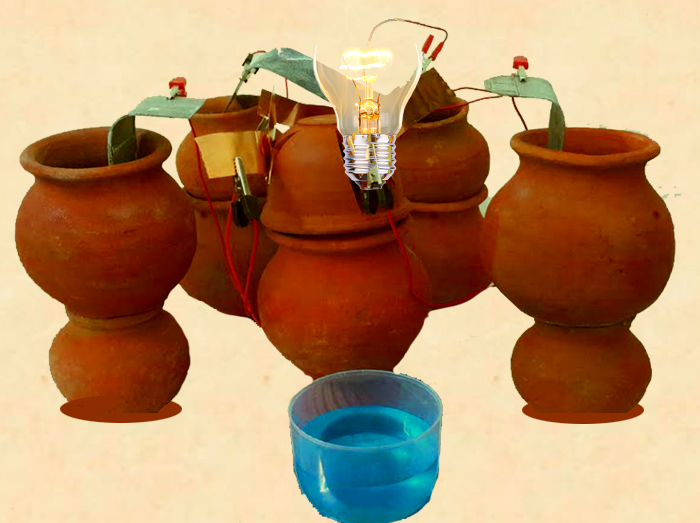
Anen Jalbhangosti Prano Daneshu Vayushu
Evam Shatanam
Kumbhanamsanyogkaryakritsmritah.
If we use the power of 100 earthen pots on water, then water will change its form into life-giving oxygen and floating hydrogen.
Vayubandhakvastren Nibaddho Yanmastake
Udanah Swalaghutve
Bibhartyakashayanakam.
If hydrogen is contained in an air tight cloth, it can be used in aerodynamics, i.e. it will fly in air. (Today’s Hydrogen Balloon)

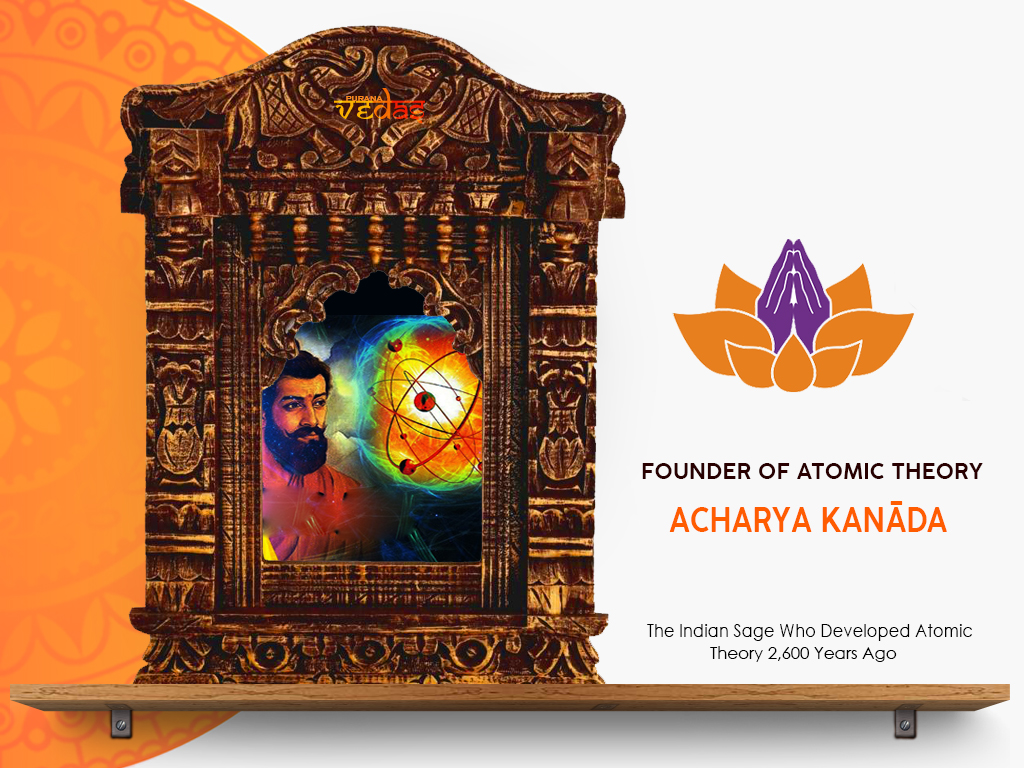
ACHARYA KANĀDA was born around 600 BC in Prabhas Kshetra which is located near Dwaraka in present-day Gujarat, India. His real name was actually KASHYAP and was the son of a philosopher named Ulka. Uluka, Kananda, and Kanabhuk was an ancient Indian scientist and philosopher who founded the “Vaisheshika” School of Indian philosophy that also represents the earliest Indian physics.
It would be surprising for many people today to know that the theory of atoms was actually formulated 2,600 years ago by an Indian sage and philosopher. The first Indian philosopher who formulated ideas about the atom systematically was Sage Kashap who lived in the 6th century B.C. His traditional name “Kanada” means “Atom Eater”, and he is known for developing the foundations of an atomistic approach to physics and philosophy in the Sanskrit text Vaiśeṣika Sūtra. “VAISESIKA DARSHAN” text is also known as Kanada Sutras or Aphorisms of Kanada.
Kanad was the earliest person in the world to converse atoms and molecules. It was Kanad who first propounded that the PARMANU (ATOMS) was an eternal particle of matter. According to the material, the universe is made up of Parmanu (ATOMS). When the matter is divided and subdivided, we reach a stage beyond which no division is possible, the indivisible element of matter is Parmanu (ATOM). Kanad introduced that this indivisible, indestructible atom cannot be sensed through any human organ.
Kanad added detained that atoms of the same substance united with each other to produce DVYANUKA (Biatomic Molecules) and TRYANUKA (Triatomic Molecules). Kanad also put forward the idea that atoms could be united in various ways to generate chemical changes in presence of other factors such as heat.
Maharshi Kanaad has mentioned in Vaisheshika Philosophy that the word Karma is related to motion. According to him, motions are of 5 types.
- Upward motion
- Downward motion
- Motion due to the release of tensile stress
- Shearing motion
- General type of motion
Newton’s Laws of Motion Published those laws in a book named “Philosophiæ Naturalis Principia Mathematia” on 5 July, 1687. But Scientist and Philosopher Maharshi Kanaad (Sage Kanaad) had discovered the laws of motion long before Newton.
First Law of Motion:
Maharshi Kanaad:- वेग : निमित्तविशेषात् कर्मणो जायते [Vega: nimitta bisheshaat karmanno jayate]
Newton:- The change of motion is due to impressed force. (Principia)
(The Law States That An Object At Rest Tends To Stay At Rest And An Object In Motion Tends To Stay In Motion With The Same Speed And In The Same Direction Unless Acted Upon By An Unbalanced Force.)
Second Law of Motion:
Maharshi Kanaad:- वेग निमित्तापेक्षात् कर्मणो जायते नियत्दिक् क्रिया प्रबंध हेतु [Vega nimittaapekshaat karmanno jaayate niyatdik kriya prawandha hetu]
Newton:- The change of motion is proportional to the motive force impressed and is made in the direction of the right line in which the force is impressed. (Principia)
Third Law of Motion
Maharshi Kanaad:- वेग : संयोगविशेष विरोधी [Vega: sangyog bishes virodhi]
Newton:- To every action there is always an equal and opposite reaction. (Principia)
In Vedic Scripture, Vaisheshika Philosophy is one important Vedic philosophy among 6 principal Philosophies. The Vaisheshika Philosophy conceptualized by the pioneer of “Anuvaad” or Atomic Theory, Kanaad aka Akshyapaad, has explained many things about life and the universe which have been established as crucial ethics in the lives of most Indian followers as per his mentions:
- There are nine constituents of realities: four classes of atoms (Earth, Water, Light And Air), Space (AKASHA), Time (KĀLA), Direction (DISHA), infinity of Souls (ATMAN), Mind (MANAS).
- Every object of creation is made of atoms (PARMANU) which in turn connect with each other to form molecules (ANU). Atoms are eternal, and their combinations constitute the empirical material world.
- Individual souls are eternal and pervade material body for a time.
- There are six categories (PADĀRTHA) of experience — Substance, Quality, Activity, Generality, Particularity, And Inherence.
Several traits of substances (DRAVYA) are given as Colour, Taste, Smell, Touch, Number, Size, The Separate, coupling and uncoupling, priority and posterity, comprehension, pleasure and pain, attraction and revulsion, and wishes.
Thus the idea of subdivision is carried further to analytical categories as well, which explains its affinity with Nyaya.

Classical Mechanics:
Classical mechanics is a form of the physics of forces acting upon bodies; includes sub-fields to describe the behaviors of Solids, Gases, and Fluids. It is often referred to as “Newtonian Mechanics” after Isaac Newton and his laws of motion. It deals with the motion of particles and the general system of particles.
To get a feel of Vedic Physical Sciences, reference to few hymns is given in the very beginning of each Veda. Indian Metaphysical Texts are replete with Gravitational laws.
1) “Madhye Samantandasya Bhugolo Vyomni Tisthati
Bibhranah Paramam Saktim Brahmano Dharanatmikam” (Surya Sidhantha 12th chapter 32 sloka)
“In the midst of universe (Brahmanda), the spherical earth stands firm in the space, because of the dharanatmika sakti, Earth is standing firm in the space without falling away.”
2) “Akrsta Saktisca Mahi Taya Yat Svastham Guru Svabhimukham Svasaktya
Akrsyate Tatpatativa Bhati Same Samantat Kva Patatviyam Khe” (Sidhanta Shiromani, Bhuvanakosa, 6th sloka)
In above Bhaskaracharya (11th Century AD) reveals that:
“Earth naturally attracts every object in the space towards itself .because of this attracting force, all objects fall on the earth .When there is balance in attraction among planets where would they fall?”
3) “Cakranasah Parinaham Prithivya” (Rig Veda 1.33.8)
“People who reside on the surface of the Earth’s circumference.”
4) “Trinābhicakramajaramanaryvam yenemā viśvā bhūvanāni tasthūḥ” (Rig Veda 1.164.1)
“All the celestial bodies (planets) are moving in elliptical orbits”
5) “Sapta Tva Haritho Rathe Vahanti Deva Surya Sociksesam Vicaksana” (Rig Veda 1.50.9)
6) “Mitro Dādhāra Prthavimūtadyām Mitraḥ Krstiḥ” (Rigveda 3.5.59.1)
Sun, with his attracting force is holding this earth and the other celestial bodies
7) Cakrāṇāsaḥ pariṇahaṁ pṛthivyā (Rigveda 10.189.1)
Moon being the sub planet of earth, is revolving around its motherly planet earth and earth is revolving around its fatherly planet sun.
8) सविता यन्त्रैः पर्थिवीमरम्णादस्कम्भने सविता दयामद्रंहत अश्वमिवाधुक्षद धुनिमन्तरिक्षमतूर्तेबद्धं सविता समुद्रम
“The sun has tied Earth and other planets through attraction and moves them around itself as if a trainer moves newly trained horses around itself holding their reins.” — (Rig Veda 10.149.1)
“The gravitational effect of solar system makes the earth stable” (Rig Veda 1-103-2, 1-115-4and 5-81-2).
“The axle of the Earth does not get rusted, the Earth continues to revolve on its axle” (Rig Veda 1-164-29).

LIGHT IN VEDIC PHYSICS
“The Sun Never Sets or Rise and It is the Earth That Rotates” (Sama Veda 121)
“Sapta Tva Haritho Rathe Vahanti Deva Surya Sociksesam Vicaksana” (Rig Veda 1.50.9)
“Ava divastarayanti Sapta Suryasya Rasmyah ” (Atharva Veda 17.10.17.1)
It says:
“Sun’s Seven Colored Rays are Making A Day”
Does that mean sun has only seven rays? No, sun emits millions of rays. But each ray of light has seven colors embedded in it. The Vedic terminology often refers to word “Saptha Asva Ruda”.It actually means seven colored white sunrays .The Vedic meaning of word “ASVA” also means “light rays”.
NAME OF SEVEN HORSES OF SUN :
The seven horses are named after the seven meters of Sanskrit prosody:
Gayatri, (Violet)
Brihati, (Indigo)
Ushnih, (Blue)
Jagati, (Green)
Trishtubha, (Yellow)
Anushtubha, and (Orange)
Pankti. (Red)
If you consider the modern Scientific explanation, you can say that the White light emitted by the Sun God consists of 7 (seven ) of the constituent colors of the White light.
“From This Engnderment, Beams of Light Shot up and Down, Gross Matters was formed and PRakriti- Divine Nature – Too Expanded in all Ten Directions, as the Sentient One Spread Itself Everywhere – High, Low , Here and Beyond” The Chandogya Upanishad.
“An Infinite Number of both Gross and Subtle atoms born from the Eternal Cause, Subtle Primordial Matter is the cause of Origin of Gross Matter that Spreads itself everywhere like the Light of the Sun.” The Rig Veda (5-47-2)

COMETS :
A train of light rarely appears in the sky. It is called “Dhuma-Ketu” by ancient Indians. Today we call it, Comet. The word “Comet” in Latin means the one that has long hair. The Western world never knew about these comets till Edmond Halley in the year 1759 pioneered the study about the comets.
The ancient Indian Astronomical texts dealt with the knowledge of comets very extensively. They are (1) Bhrhat vimana sastra written by Bharadwaj (2) Agastya’s sakti tantra (3) Jaimini’s keta sarvasa. In Agastya’s Sakti Tantra, the names of Twelve Comets are given. It had been mentioned that during the rainy season the potency of comets would be very high.
Vimana Sastra says that the Comets are formed because of Sun burning certain objects in its vicinity, please do not forget the word “DHUMA” in Sanskrit means smoke or gases. The modern knowledge about the comets also concurs with that.

SOUND IN VEDIC PHYSICS
Ancient Indians duly recognized the importance of sound & sound energies.
Ancient Indians had also utilized sound energy in various ways. Indians knew the secrets of sound and made extensive use of them in many day-to-day activities.
When ancient Indian literature declares that this universe had come out from the first breath of God, it’s about the first vibration of that cosmic energy, the first explosion (MAHA VISPHOTAM in Sanskrit), the modern Big Bang theory.
Indians used sound energy in many ways; Indian classical music is nothing but an applied science of sound energy. Melodious music charms snakes; Wild animals get tamed; Cows give excess milk; Plants blossom with flowers; Trees bear fruits; Rains pour out; Nature responds with joy; Lamps can be lit just by the melody of the music; many a disease can be cured through the science of music, it is an application of sound vibrations. The knowledge of mantras is again an applied aspect of sound. Ancient Indians played with sound, enjoyed the sound, and protected themselves with sound vibrations.

STRING THEORY
Modern science is yet to conclude that sub atomic particles like quark particles and lepton particles are basic building blocks of the universe.
Reason for this is that scientists could unite three of the four fundamental forces of interaction among subatomic particles, they are:
- Electro – Magnetic Forces
- Strong Nuclear Forces
- Weak Nuclear Forces
By uniting the three forces, scientists could study the behavior and properties of quark and lepton particles. Yet they could not unite the fourth fundamental force i.e. gravitational force with the other three forces in studying the behavior pattern of subatomic particles.
During the last years of the 20th century, scientists had proposed a new theory called string theory. According to that, quarks and leptons are not particles. They are the subtle vibrating strings with closed and open loops. The gigantic star and minutest quark string are connected through a superstring. Hence the whole universe is being considered as one unit by the most modern concepts of science. This theory facilities the study of all the four fundamental forces of interactions.
In Vedas in Sata Pata Brahmana, it is said that the sun and the entire universe are connected in a string. That string is Vayu. Please note that Vayu is not gas or air according to Vedic meaning. Veda Nirukta defines it as one that pervades everything.
Ancient Vedic knowledge recognized everything in the universe as one consciousness and cultured our minds in that direction. There is huge literature to support this fact. Modern science is also reaching the same conclusions.

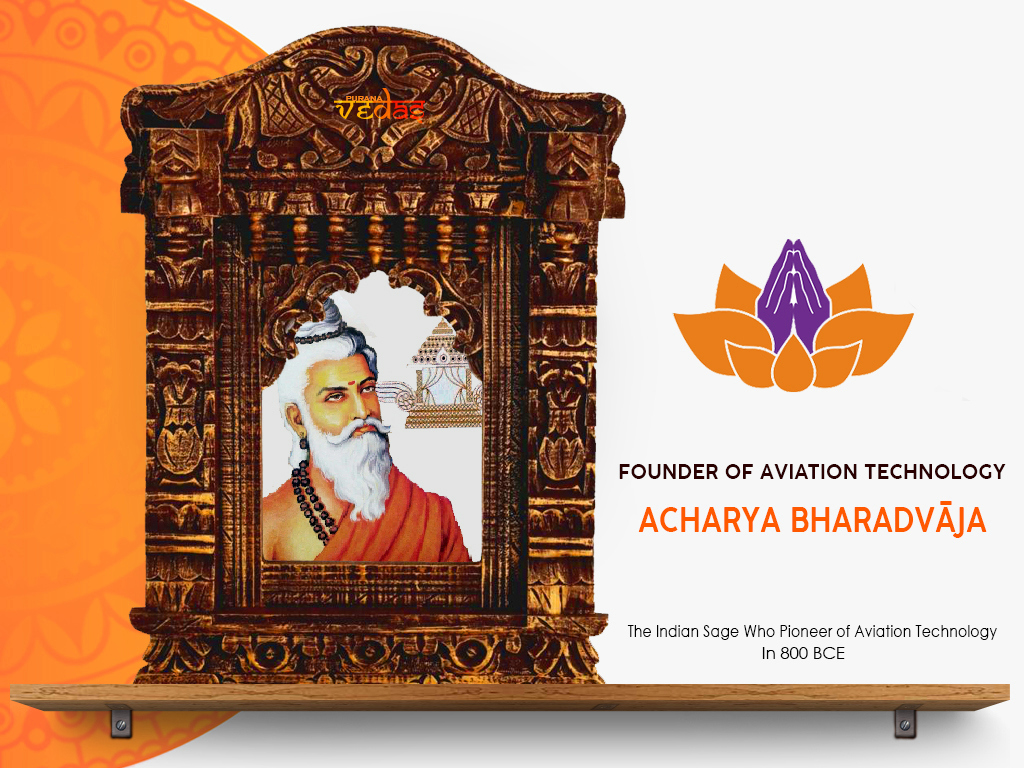
Maharshi Bharadvāja, also referred to as Guru or Bharadvaja Bṛhaspatya, was one of the honored Vedic sages in Ancient India. Acharya Bharadwaj had a hermitage in the holy city of Prayag (Allahabad, Uttar Pradesh (India) and was a dedicated follower of Ayurveda and Mechanical Sciences. He authored the “YANTRA SARVASVA” which includes astonishing and outstanding discoveries in Aviation science, Space science, and Flying machines.
Bharadvaja Barhaspatya, the last name referring to his father and Vedic sage Brihaspati. His mother was Mamata, the wife of Utathya Rishi who was the elder brother of Brhaspati. He is one of the seven Rishis mentioned four times in the Rigveda as well as in the Shatapatha Brahmana, thereafter revered in the Mahabharata and the Puranas. In later Puranic legends, he is stated to be the son of Vedic sage Atri.
The Vaimānika Śāstra (वैमानिक शास्त्र, lit. “Shastra on the topic of Vimanas“; or “Science of Aeronautics” sometimes also rendered Vimanika, Vymanika, Vyamanika) It contains 3000 shlokas in 8 chapters which Author claimed was psychically delivered to him by the ancient Vedic sage Bharadvaja.
For almost twenty years, many scientists at the Aeronautical Society of India, NASA, professors, and students of many prominent universities of the world were researching their own way on this Vaimanaki Sastra of Bharadwaj. They were able to appreciate the advanced level of knowledge about Aeronautics in this book. But much of their research findings are not being revealed to the public.
Bharadwaj had dealt about four types of fuels that can be used by Vimanas (Aircraft’s). They are:
- Vanaspati Oil
- Mercury Gas
- Solar Energy
- Directly consuming power from the air
Unlike modern treatises on aeronautics that begin by discussing the general principles of flight before detailing concepts of aircraft design, the VAIMĀNIKA SHĀSTRA starts with a quantitative description, as though a particular aircraft is being described. The topics covered include, Definition of an airplane, a pilot, aerial routes, food, clothing, metals, metal production, mirrors and their uses in wars, varieties of machinery and yantras, planes like ‘MANTRIK’, ‘TANTRIK’, AND ‘KRITAK’” and four planes called SHAKUNA, SUNDARA, RUKMA, and Tripura are described in greater detail. The extant text is claimed to be only a small (one-fortieth) part of a larger work by Yantra Sarvaswa.
Aircraft Building technology is mentioned in the Sanskrit Text written by Bharadwaj called “Yantra Sarvasvam”. Siva Kumar Bapuji Talpade is a Sanskrit Scholer who adopted the technology from the chapters of “VAIMANIKA SASTRA” of Bharadwaja’s book and invented Aircraft Its Named as “Maruti Shakti“, The then British Government, after strictly warning the Baroda maharaja not to fund the project, stalled this experiment. It seems that the experimental remnants of the plane and various working plans had been taken over by the British Government.
Eight years before the Wright brothers’ aerial show, in India in the year 1895, at the Chowpatty beach in Bombay, an aircraft flew in the skies up to 1,500 ft., when a large Indian audience watched this feat. And this performance happened in the august presence of His Highness Maharaja of Baroda Sri Sayaji Rao Gaikwad and honorable Judge Mahadev Govind Ranade. This event was covered and published by the then-popular newspaper “Kesari” which was published from Pune.
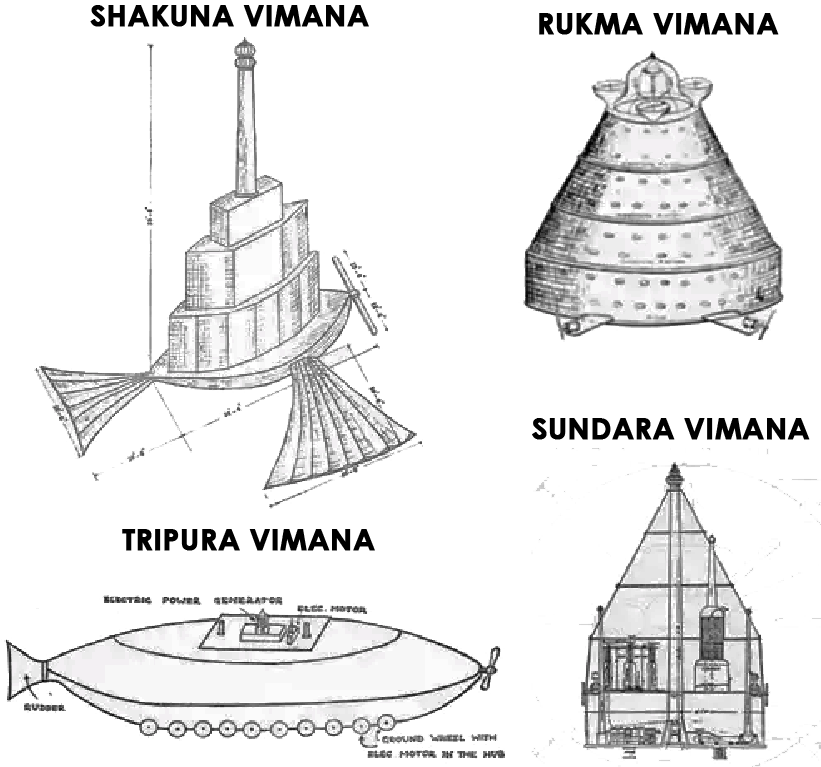
He has described three categories of flying machines:
1.) One that flies on earth from one place to another.
2.) One that travels from one planet to another.
3.) And One that travels from one universe to another. His designs and descriptions have impressed and amazed aviation engineers of today.
His brilliance in aviation technology is further reflected through techniques described by him:
1.) Profound Secret: The technique to make a flying machine invisible through the application of sunlight and wind force.
2.) Living Secret: The technique to make an invisible space machine visible through the application of electrical force.
3.) Secret of Eavesdropping: The technique to listen to a conversation in another plane.
4.) Visual Secrets: The technique to see what’s happening inside another plane.
Through his innovative and brilliant discoveries, Acharya Bharadwaj has been recognized as the pioneer of aviation technology.

